Western Australia maybe famous for its enormous diversity of wildflowers, but when we headed east from the Camel Soak on September 16, 2013 our group was drawn by a single plant. The broad, sandy road verges were ideal beds for the Wreath Flower or Wreath Leschenaultia (Leschenaultia macrantha), a draw for tourists and a remarkable-looking plant, made all the more striking by the gallery of flowers that grow around it. When we finally reached the Wreath Flower colony, Eileen found it hard to believe that its home was not a landscaped garden instead of, simply, an overgrown road shoulder. I found it hard to disagree with her.
Wreath Flowers are all the more striking against the relative drabness of the surrounding landscape, a place where the chief bit of excitement might be the passage of a road train. For those unused to these particularly Australian phenomena, road trains are tractor trucks pulling not one but, sometimes, several trailers behind them. Seeing one of them heading towards you, the trailers at its far end weaving back and forth over the road, can be an unnerving experience (especially if you are photographing flowers on the road shoulder).
Roads have probably increased the Wreath Flower population (though Philip Moore's A Guide to the Plants of Inland Australia (2005; Reed New Holland) notes that the plant "appears to be vulnerable to exploitation, development and vandalism"). These are sprawling, ground-hugging plants. They need room, and road shoulders provide it in abundance.
Other plants seem to appreciate road-building efforts, too. Bright yellow clumps of Popflower (Glischrocaryon sp) set off the pink mats of Leschenaultia, adding greatly to the planted-garden effect.
Three very similar species of Glischrocaryon occur in this part of Western Australia; I am not sure which this is.
Native Foxglove ( Dasymalla terminalis, previously known as Pityrodia terminalis) provides an accent plant with a spray of deep pink (it can be much paler, or even white, in other parts of its range).
Native Foxglove is a member of the mint family (Lamiaceae), and is therefore unrelated to the garden foxgloves (Digitalis sp) which belong in the Scrophulareaceae (now Plantaginaceae). The greyish cast to everything but the flower is created by a coating of hairs, a protection against the sun shared by many dry-country plants.
Lachnostachys, a small western Australian genus also in the mint family, carries the woolly-in-the-desert look to an extreme. This is Lambs' Tails (Lachnostachys verbascifolia).
Tinsel flowers (Cyanostegia) are also members of the mint family. Three of the five species in the genus live in the area: Cyanostegia microphylla, C. corifolia and C. longifolia. This could be any one of them.
This, I believe, is one of the others - certainly it is another Cyanostegia.
The scattered trees in the area were, as they usually are in the dry interior of Australia, mostly wattles (Acacia) of one sort or another, each adding its own splash of yellow to the landscape.
The spindly stems of Drummond's Poverty Bush (or Drummond's Emubush) (Eremophila drummondii) are dotted with blue flowers, a sign that this is a plant pollinated by insects. The lower lip of the flower provides them with a landing platform, and little streaks guide them into the flower's depths, where its nectar is hidden. Another group of Emubushes are adapted to be pollinated by birds. They have pink, yellow or orange blooms, with protruding stamens that dab a visiting bird's head with pollen as it probes the flower.
The yellow flowers of various species of Hibbertia are a common sight in Western Australia, but with rare exceptions they only penetrate the edges of the dry country.
The excessively hairy stems of this plant suggest that it is very much adapted to the hot, dry interior. I have been unable to find out what it is, but its notched petals suggest that it is one of the Goodeniaceae.
This is a species of Keraudrenia, a member of the mallow family (Malvaceae) - probably Common Firebush (K. integrifolia). The plants get their name from their tendency to reappear after a bush fire. The purple flower parts are not petals, but sepals; the true petals are missing.
Among the tinier plants in the wreath-flower garden was this attractive little trigger flower (Stylidium sp).
Wells' Dampiera (Dampiera wellsiana) is another attractive little dry-country flower, endemic to the inland southwest.
This one has attracted a potential pollinator: a Tangle-veined Fly (Trichophthalma sp.). Tangle-veined flies (Family Nemestrinidae) both look and act like bees. There are about 300 species worldwide, and the family has been around for a long time; it was already well established in the Jurassic.
OK, back to the Wreath Flowers!
A closeup look shows that, at least as far as its flowers go, the Wreath Flower is a fairly typical, if very pretty, Leschenaultia.
What catches the eye, of course, is its unusual growth form. How did it get this way?
The secret of its odd shape is most easily revealed in a young plant. It's quite simple, really; shoots grow out from a central root like spokes radiating from the hub of a bicycle wheel, scramble along the ground, and flower at their tips.
The result, once the shoots leaf out enough to blend together, is usually something fairly close to the circular form of a wreath.
Sometime two plants merge into each other, creating a more or less oval shape.
Here are three overlapping wreaths, in a neat row.
The result: a beautiful, unusual and justly renowned plant, worth a long drive into the desert to see.
Wreath Flowers are all the more striking against the relative drabness of the surrounding landscape, a place where the chief bit of excitement might be the passage of a road train. For those unused to these particularly Australian phenomena, road trains are tractor trucks pulling not one but, sometimes, several trailers behind them. Seeing one of them heading towards you, the trailers at its far end weaving back and forth over the road, can be an unnerving experience (especially if you are photographing flowers on the road shoulder).
Roads have probably increased the Wreath Flower population (though Philip Moore's A Guide to the Plants of Inland Australia (2005; Reed New Holland) notes that the plant "appears to be vulnerable to exploitation, development and vandalism"). These are sprawling, ground-hugging plants. They need room, and road shoulders provide it in abundance.
Other plants seem to appreciate road-building efforts, too. Bright yellow clumps of Popflower (Glischrocaryon sp) set off the pink mats of Leschenaultia, adding greatly to the planted-garden effect.
Three very similar species of Glischrocaryon occur in this part of Western Australia; I am not sure which this is.
Native Foxglove ( Dasymalla terminalis, previously known as Pityrodia terminalis) provides an accent plant with a spray of deep pink (it can be much paler, or even white, in other parts of its range).
Native Foxglove is a member of the mint family (Lamiaceae), and is therefore unrelated to the garden foxgloves (Digitalis sp) which belong in the Scrophulareaceae (now Plantaginaceae). The greyish cast to everything but the flower is created by a coating of hairs, a protection against the sun shared by many dry-country plants.
Lachnostachys, a small western Australian genus also in the mint family, carries the woolly-in-the-desert look to an extreme. This is Lambs' Tails (Lachnostachys verbascifolia).
Tinsel flowers (Cyanostegia) are also members of the mint family. Three of the five species in the genus live in the area: Cyanostegia microphylla, C. corifolia and C. longifolia. This could be any one of them.
This, I believe, is one of the others - certainly it is another Cyanostegia.
The scattered trees in the area were, as they usually are in the dry interior of Australia, mostly wattles (Acacia) of one sort or another, each adding its own splash of yellow to the landscape.
The spindly stems of Drummond's Poverty Bush (or Drummond's Emubush) (Eremophila drummondii) are dotted with blue flowers, a sign that this is a plant pollinated by insects. The lower lip of the flower provides them with a landing platform, and little streaks guide them into the flower's depths, where its nectar is hidden. Another group of Emubushes are adapted to be pollinated by birds. They have pink, yellow or orange blooms, with protruding stamens that dab a visiting bird's head with pollen as it probes the flower.
The yellow flowers of various species of Hibbertia are a common sight in Western Australia, but with rare exceptions they only penetrate the edges of the dry country.
The excessively hairy stems of this plant suggest that it is very much adapted to the hot, dry interior. I have been unable to find out what it is, but its notched petals suggest that it is one of the Goodeniaceae.
This is a species of Keraudrenia, a member of the mallow family (Malvaceae) - probably Common Firebush (K. integrifolia). The plants get their name from their tendency to reappear after a bush fire. The purple flower parts are not petals, but sepals; the true petals are missing.
Among the tinier plants in the wreath-flower garden was this attractive little trigger flower (Stylidium sp).
Wells' Dampiera (Dampiera wellsiana) is another attractive little dry-country flower, endemic to the inland southwest.
This one has attracted a potential pollinator: a Tangle-veined Fly (Trichophthalma sp.). Tangle-veined flies (Family Nemestrinidae) both look and act like bees. There are about 300 species worldwide, and the family has been around for a long time; it was already well established in the Jurassic.
OK, back to the Wreath Flowers!
A closeup look shows that, at least as far as its flowers go, the Wreath Flower is a fairly typical, if very pretty, Leschenaultia.
What catches the eye, of course, is its unusual growth form. How did it get this way?
The secret of its odd shape is most easily revealed in a young plant. It's quite simple, really; shoots grow out from a central root like spokes radiating from the hub of a bicycle wheel, scramble along the ground, and flower at their tips.
The result, once the shoots leaf out enough to blend together, is usually something fairly close to the circular form of a wreath.
Sometime two plants merge into each other, creating a more or less oval shape.
Here are three overlapping wreaths, in a neat row.
The result: a beautiful, unusual and justly renowned plant, worth a long drive into the desert to see.









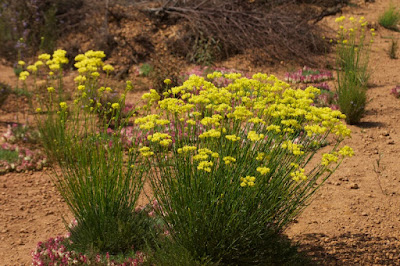



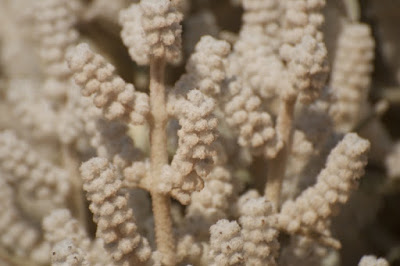














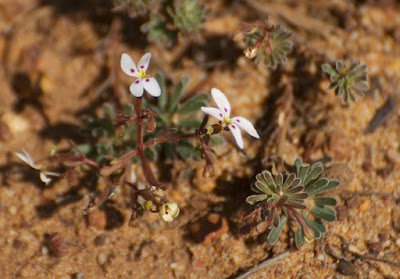





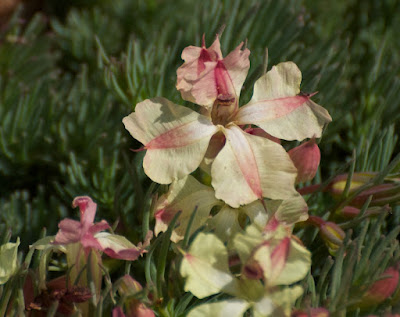

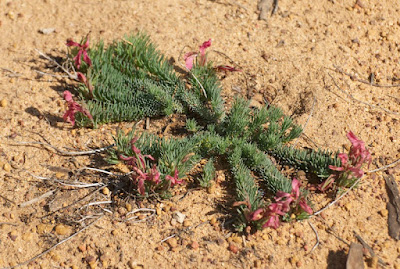




Great stuff as usual, am enjoying your posts from Downunder!!
ReplyDeleteThanks! Readers might want to check out Neal's very enjoyable bird photography blog at http://nealsbirdblog.blogspot.ca/.
ReplyDelete